In the previous pdf-note, we have learned about the superficial muscles of the back. In this pdf-note, we will learn more about the deep muscles of the back.
As discussed in the previous pdf-notes, the back region has the following borders:
The superior border consists of the external occipital protuberance and the superior nuchal line
The inferior border consists of the sacro-iliac joints, posterior segments of the ilium bones crests, coccyx
The lateral border is the posterior median line
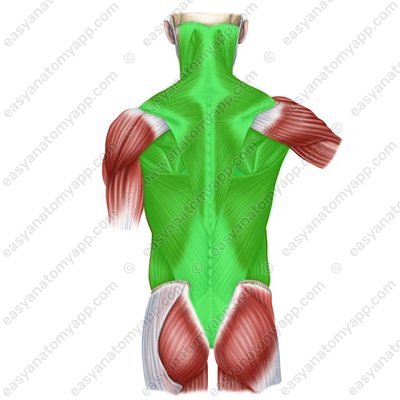
There are several anatomical regions within the back:
Vertebral region (regio vertebralis)
Scapular region (regio scapularis)
Infrascapular region (regio infrascapularis)
Lumbar region (regio lumbalis)
Sacral region (regio sacralis)
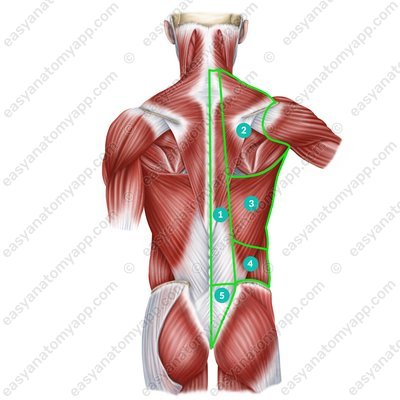
The muscles of the back are located within these regions. The deep muscles of the back include:
First layer
Splenius capitis muscle (m. splenius capitis)
Splenius capitis muscle (m. splenius capitis) 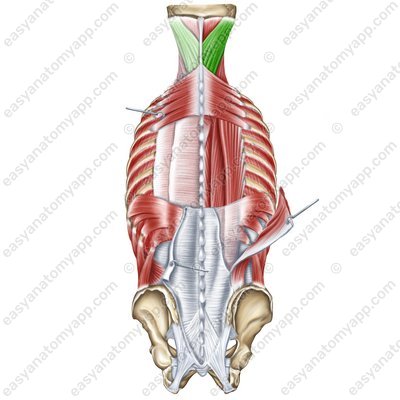
Splenius capitis muscle (m. splenius capitis) 
Splenius capitis muscle
(m. splenius capitis)Origin: spinous processes of the C7-Th3 (sometimes Th4) vertebrae, nuchal ligament
Insertion: lateral segment of the superior nuchal line, mastoid process of the temporal bone
Function: with bilateral contraction, it extends the neck and head, with unilateral contraction, it turns and slightly tilts the head ipsilaterally (in its own direction)
Innervation: posterior branches of the cervical spinal nerves (C2-C3)
Blood supply: occipital artery, deep cervical artery
Splenius cervicis muscle (m. splenius cervicis)
Splenius cervicis muscle (m. splenius cervicis) 
Splenius cervicis muscle (m. splenius cervicis) .jpg)
Splenius cervicis muscle
(m. splenius cervicis)Origin: spinous processes of the Th3-Th6 vertebrae
Insertion: transverse processes of the C1-C3 vertebrae
Function: with bilateral contraction, it extends the neck, with unilateral contraction, it turns and slightly tilts the neck ipsilaterally (in its own direction)
Innervation: posterior branches of the cervical spinal nerves (C3-C8)
Blood supply: occipital artery, deep cervical artery
Erector spinae muscle (m. erector spinae), which consists of three separate muscles:
Erector spinae muscle (m. erector spinae) 
Erector spinae muscle (m. erector spinae) 
Iliocostalis muscle (m. iliocostalis)
Iliocostalis muscle (m. iliocostalis) 

Iliocostalis muscle – capitis part (m. iliocostalis capitis) Iliocostalis muscle – cervical part (m. iliocostalis cervicis) .jpg)
Iliocostalis muscle – thoracic part (m. iliocostalis thoracis) 
Iliocostalis muscle – lumbar part (m. iliocostalis lumborum) 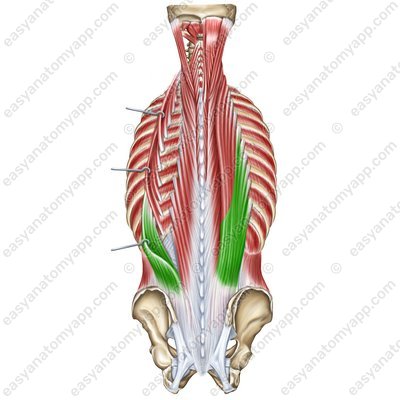
Iliocostalis muscle
(m. iliocostalis)Origin:
Cervical part arises from the angles of the ribs 3-6
Thoracic part arises from the angles of the ribs 7-12
Lumbar part arises from the lateral crest of the sacrum, the medial end of the iliac crest, and the thoracolumbar fascia
Insertion:
Cervical part inserts into the transverse processes of the C4-C6 vertebrae
Thoracic part inserts into the angles of the ribs 1-6, and the transverse process of the C7 vertebra
Lumbar part inserts into the angles of the ribs 5-12, the transverse processes of the vertebrae L1-L4, as well as the adhering segments of the thoracolumbar fascia
Function: with bilateral contraction, it extends the vertebral column, with unilateral contraction, it tilts the vertebral column ipsilaterally (in its own direction) and lowers the ribs
Innervation: posterior branches of spinal nerves (C3-L4)
Blood supply: deep cervical artery, posterior intercostal arteries, lumbar arteries
Longissimus muscle (m. longissimus)
Longissimus muscle (m. longissimus) 
Longissimus muscle – cranial part (m. longissimus capitis) 
Longissimus muscle – cervices part (m. longissimus cervicis) .jpg)
Longissimus muscle – thoracis part (m. longissimus thoracis) 
Longissimus muscle
(m. longissimus)Origin:
Cranial part arises from the transverse processes of the C4-Th5 vertebrae
Cervical part arises from the transverse processes of the Th1-Th5 vertebrae
Thoracic part arises from the spinous and transverse processes of the L1-L5 vertebrae, median sacral crest, posterior surface of the sacrum, posterior parts of the iliac crest
Lumbar part arises from the lumbar intermuscular aponeurosis, anteromedial segments of the iliac bone, posterior sacro-iliac ligament
Insertion:
Cranial part inserts into the mastoid process of the temporal bone
Cervical part inserts into the transverse processes of the C2-C6 vertebrae
Thoracic part inserts into the transverse processes of the T1-Th12 vertebrae, angles of the ribs 7-12
Lumbar part inserts into the accessory and transverse processes of the L1-L5 vertebrae
Function: with bilateral contraction, it extends the vertebral column, with unilateral contraction, it tilts the vertebral column ipsilaterally (in its own direction).
Additional function of the cranial part: with bilateral contraction, it extends the neck and head, with unilateral contraction, it turns and slightly tilts the head ipsilaterally (in its own direction)
Innervation: posterior branches of spinal nerves (C3-L4)
Blood supply: deep cervical artery, posterior intercostal, lumbar arteries
Spinalis muscle (m. spinalis)

Spinalis muscle (m. spinalis) 
Spinalis muscle – cranial part (m. spinalis capitis) .jpg)
Spinalis muscle – cervical part (m. spinalis cervicis) Spinalis muscle – thoracic part (m. spinalis thoracis) 
Spinalis muscle
(m. spinalis)Origin:
Cervical part arises from the spinous processes of the C7-Th1 vertebrae, nuchal ligament
Thoracic part arises from the spinous processes of the Th11-L2 vertebrae
Insertion:
Cervical part inserts into spinous processes of the C2-C4 vertebrae
Thoracic part inserts into spinous processes of the Th2-Th8 vertebrae
Function: with bilateral contraction, it extends the cervical and thoracic spine; with unilateral contraction, it turns the cervical and thoracic spine ipsilaterally (in its own direction)
Innervation: posterior branches of spinal nerves (C3-L4)
Blood supply: deep cervical artery, posterior intercostal arteries
Second layer
Transversospinalis muscle (m. transversospinalis), which consists of three separate muscles:
Transversospinalis muscle (m. transversospinalis) 
Transversospinalis muscle (m. transversospinalis) 
Semispinalis muscle (m. semispinalis)
Semispinalis muscle (m. semispinalis) 
Semispinalis muscle – cranial part (m. semispinalis capitis) 
Semispinalis muscle – cervical part (m. semispinalis cervicis) .jpg)
Semispinalis muscle – thoracic part (m. semispinalis thoracis) 
Semispinalis muscle
(m. semispinalis)Origin:
Cranial part arises from the articular processes of the C4-C7 vertebrae, transverse processes of the Th1-Th6 vertebrae
Cervical part arises from the transverse processes of the Th1-Th6 vertebrae
Thoracic part arises from the transverse processes of the Th6-Th10 vertebrae
Insertion:
Cranial part inserts into the between the superior and inferior nuchal lines of the occipital bone
Cervical part inserts into the spinous processes of the C2-C5 vertebrae
Thoracic part inserts into the spinous processes of the C6-Th4 vertebrae
Function: with bilateral contraction, it extends the head, cervical and thoracic spine; with unilateral contraction, it tilts the head, cervical and thoracic spine ipsilaterally (in its own direction) and turns the head, cervical and thoracic spine contralaterally (in the opposite direction)
Innervation:
Cranial part: descending branches of the greater occipital nerve (C2) and the C3 spinal nerve.
Cervical and thoracic parts: posterior branches of spinal nerves (C3-Th12)
Blood supply: deep cervical artery, posterior intercostal arteries
Multifidi muscles (mm. multifidi)
Multifidi muscles (mm. multifidi) 
Multifidi muscles – cervical part (m. multifidus cervicis) .jpg)
Multifidi muscles – thoracic part (m. multifidus thoracis) 
Multifidi muscles – lumbar part (m. multifidus lumborum) 
Multifidi muscles
(mm. multifidi)Origin:
Cervical part arises from the superior articular processes of the C4-C7 vertebrae
Thoracic part arises from the transverse processes of the thoracic vertebrae
Lumbar part arises from the mastoid processes of the lumbar vertebrae, posterior surface of the sacrum, posterior superior iliac spine, posterior sacro-iliac ligament
Insertion: spinous processes of the superposed vertebraes (2-5 vertebrae higher)
Function: with bilateral contraction, it extends the vertebral column, with unilateral contraction, it tilts the vertebral column ipsilaterally (in its own direction) and turns the vertebral column contralaterally (in the opposite direction).
Innervation: posterior branches of spinal nerves (C3-S1).
Blood supply: deep cervical artery, posterior intercostal arteries, lumbar arteries
Rotatores muscles (mm. rotatores)
Rotatores muscles (mm. rotatores) 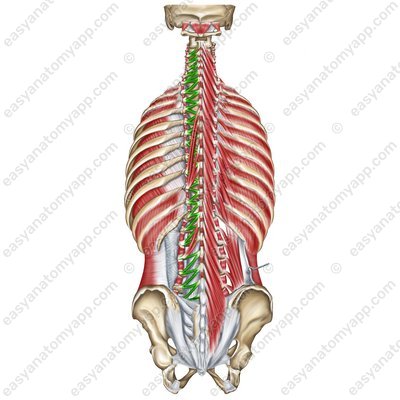
Rotatores muscles – cervical part (mm. rotatores cervicis) .jpg)
Rotatores muscles – thoracic part (mm. rotatores thoracis) 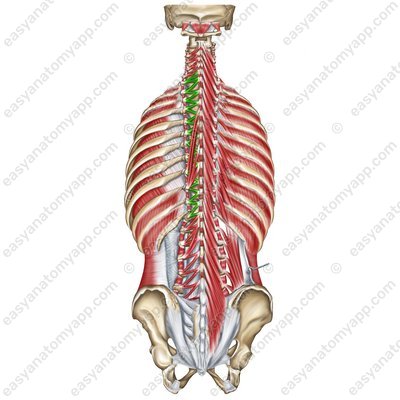
Rotatores muscles – lumbar part (mm. rotatores lumborum) 
Rotatores muscles
(mm. rotatores)Origin:
Short muscles arise from the transverse processes of the Th2-Th12 vertebrae
Long muscles arise from the transverse processes of the thoracic vertebrae
Insertion:
Short muscles insert into the bases of the spinous processes of the superposed vertebrae (1 vertebra higher)
Long muscles insert into the bases of the spinous processes of the superposed vertebrae (2 vertebrae higher)
Function: with bilateral contraction, it extends the thoracic spine; with unilateral contraction, it turns the thoracic spine in the opposite direction
Innervation: posterior branches of thoracic spinal nerves
Blood supply: deep cervical artery, posterior intercostal arteries, lumbar arteries
Third layer
Interspinales muscles (mm. interspinales)
Interspinales muscles (mm. interspinales) 
Interspinales muscles – cervical part (mm. interspinales cervicis) .jpg)

Interspinales muscles – thoracic part (mm. interspinales thoracis) 
Interspinales muscles – lumbar part (mm. interspinales lumborum) Interspinales muscles
(mm. interspinales)Origin:
Cervical part arises from the spinous processes of the C2-C7 vertebrae
Thoracic part arises from the spinous processes of the Th2, Th11, Th12 vertebrae
Lumbar part arises from the spinous processes of the L2-L5 vertebrae
Insertion: into the superposed vertebrae:
Cervical part inserts into the spinous processes of the C1-C6 vertebrae
Thoracic part inserts into the spinous processes of the Th1, Th10, Th11 vertebrae
Lumbar part inserts into the spinous processes of the L1-L4 vertebrae
Function: extends the vertebral column (which is poorly expressed in the thoracic region, therefore, for the most part in relation to the cervical and lumbar regions)
Innervation: posterior branches of spinal nerves (C3-L5)
Blood supply: deep cervical artery, posterior intercostal arteries, lumbar arteries
Intertransversarii muscles (mm. intertransversarii)

.jpg)


(mm. intertransversarii)
Origin:
Anterior cervical fasciculi arise from the anterior tubercles of the transverse processes of the C2-Th1 vertebrae
Posterior cervical fasciculi arise from the posterior tubercles of the transverse processes of the C2-Th1 vertebrae
Medial lumbar fasciculi arise from the accessory processes of the L1-L4 vertebrae
Lateral lumbar fasciculi arise from the transverse (and partially the accessory) processes of the L1-L4 vertebrae
Insertion:
Anterior cervical fasciculi insert into the anterior tubercles of the transverse processes of the superposed vertebrae
Posterior cervical fasciculi insert into the posterior tubercles of the transverse processes of the superposed vertebrae
Medial lumbar fasciculi insert into the accessory processes of the superposed vertebrae
Lateral lumbar fasciculi insert into the transverse (and partially the accessory) processes of the superposed vertebrae
Function: tilts the vertebral column in its direction (which is poorly expressed in the thoracic region, therefore, for the most part in relation to the cervical and lumbar regions)
Innervation:
Cervical muscles: anterior and posterior branches of the cervical spinal nerves
Lumbar muscles: anterior branches of the lumbar spinal nerves
Blood supply: deep cervical artery, posterior intercostal arteries, lumbar arteries
Some sources also list the levatores costarum muscles (mm. levatores costarum) here.
(mm. levatores costarum)
Origin: transverse processes of the C7-Th11 vertebrae
Insertion: superior margins of the underlying ribs
Function: lift the ribs, rotate the thoracic spine
Innervation: intercostal nerves (C3, Th1, Th2, Th6-Th10)
Blood supply: posterior intercostal arteries
There are also the muscles of the dorsal region of the neck called the suboccipital muscles, which are considered in the corresponding pdf-note.
Intrinsic back muscle
- Splenius capitis muscle
- m. splenius capitis
- Splenius cervicis muscle
- m. splenius cervicis
- Erector spinae muscle
- m. erector spinae
- Iliocostalis muscle
- m. iliocostalis
- Longissimus muscle
- m. longissimus
- Spinalis muscle
- m. spinalis
- Transversospinalis muscle
- m. transversospinalis
- Semispinalis muscle
- m. semispinalis
- Multifidi muscles
- mm. multifidi
- Rotatores muscles
- mm. rotatores
- Interspinales muscles
- mm. interspinales
- Intertransversarii muscles
- mm. intertransversarii
- Levatores costarum muscles
- mm. levatores costarum


